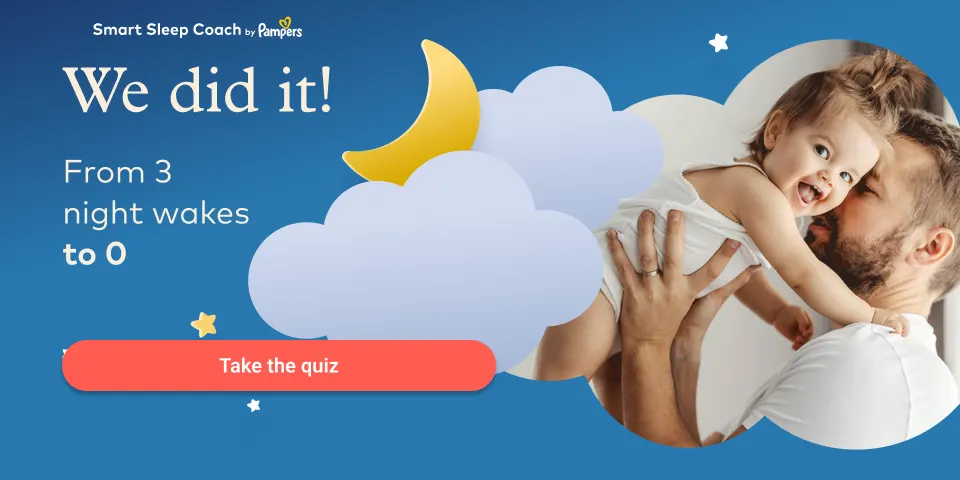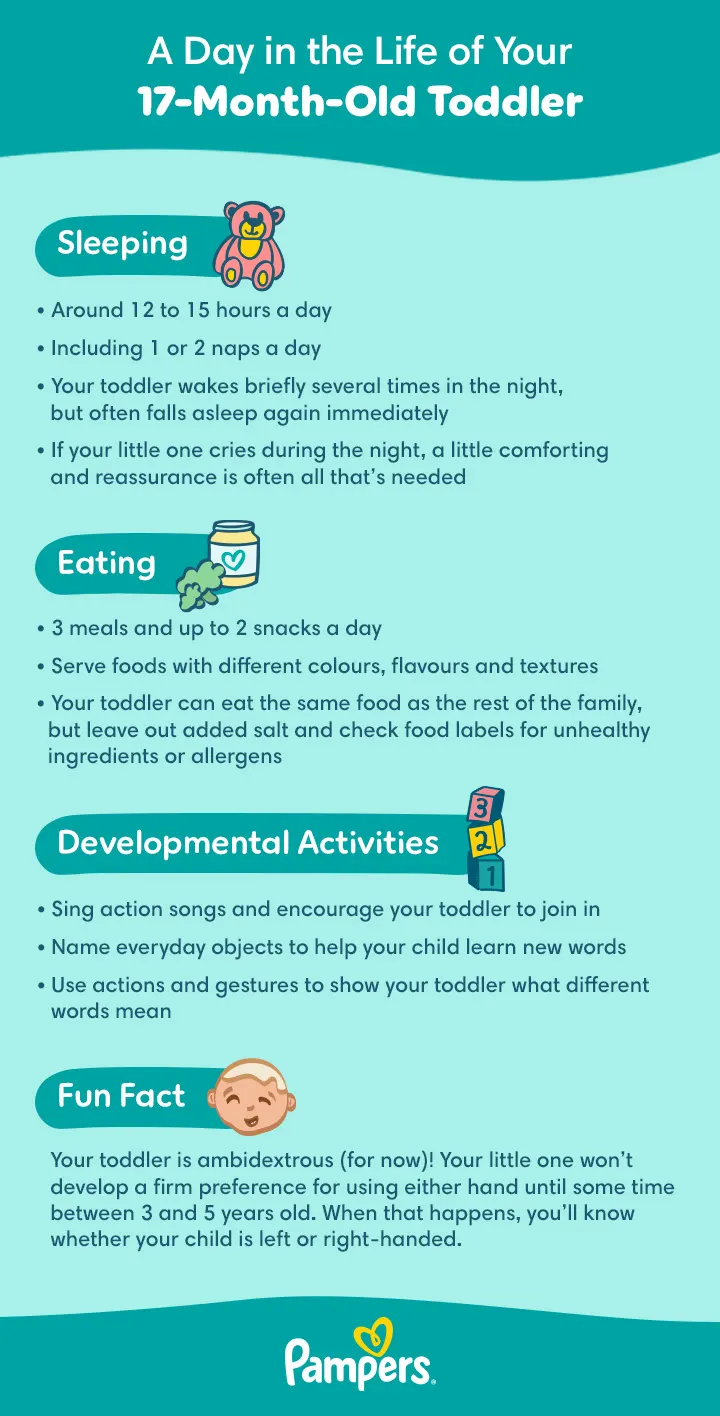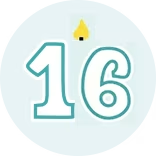17-Month-Old: Talkative and Mobile
Your toddler’s vocabulary and speech may be developing apace at around 17 months old, but don’t worry if your child is not talking as much as you expected by now. Some children reach the various development milestones a little earlier or later than others – and your little one can already understand many more words than he or she can say.
Read on to find out what might be in store for your 17-month-old this month.
Toddler Development Milestones
Although it’s hard to predict exactly which milestones your 17-month-old will reach this month, here are a few aspects of your toddler’s development that might come into focus around now:
Movement: Balancing and Climbing Stairs
At 17 months old your toddler could be getting steadier on his or her feet all the time. Compared to only a few weeks or months ago, your child is probably walking more confidently now, and might – already or sometime soon – be able to walk up stairs while holding your hand.
As your toddler’s balance improves, your budding athlete will learn to do all sorts of things with his or her hands and feet while on the move, like trying to kick or throw a ball.
Activities: Building Towers
Your toddler now has the fine motor skills to pick up small objects between the thumb and forefinger more easily. As your child’s coordination improves, you’ll notice your toddler doing more and more complex hand and finger tasks, from building towers out of building blocks to eating with a spoon at mealtimes.
Language Development: A Little More Complexity
In the next few weeks or months, your toddler may be able to follow instructions that contain not just one, but up to two key words. For example, ‘bring the cup and the bowl’. Your 17-month-old will also soon (or already) understand actions words like ‘stand up’ and ‘run to Mummy’.
At 17 months old, your toddler may be able to say several words (although not always clearly). At this point, your child’s vocabulary probably consists of words for familiar people and objects.
Soon, if it hasn’t happened already, your toddler may start putting words together into little phrases like ‘all gone!’ or ‘Granny bye bye’.
Even if your 17-month-old is not talking as much as you’d expected yet, you might be surprised how much he or she already understands. In fact, experts believe that your little one’s ‘passive’ vocabulary – the number of words your child understands but doesn’t say out loud yet – could be five times as many as the words your toddler can say.
How to Support Your Toddler’s Development
Here are some ways that you can support your 17-month-old’s development:
Name everyday objects. Help your child develop word associations by naming and explaining common objects and everyday activities. For example, when it’s time to get dressed lay out your toddler’s clothes on the bed and ask him or her to get each garment for you.
Put those new-found sorting skills to use. Now that your 17-month-old is learning to recognise basic shapes and colours, get your toddler involved in household tasks like sorting the washing into different colours.
Teach your child nursery rhymes. Sing nursery rhymes like ‘Twinkle Twinkle Little Star’ or ‘The Wheels on the Bus’ and encourage your toddler to join in. Besides being fun for you both and a great bonding experience, it can also help develop your child’s listening and language skills. Your child loves the sound of your voice and enjoys the rhythm and melodies of the songs and rhymes, as well as the repetition. Songs with actions can be even more fun for both of you.
Read to your toddler. It’s never too early to start reading to your child, but it could be even more enjoyable now that your 17-month-old can turn the pages of a book and even point to some of the pictures when you name them. Incorporating a story into your child’s bedtime routine is a great way of helping your toddler wind down for sleep.
Mealtimes for Your 17-Month-Old
At 17 months old, your toddler needs about 3 small meals and 2 healthy snacks a day on average, but you may find that your child is hungrier some days and wants to skip the occasional meal or snack on others.
You might worry that your child isn’t getting enough to eat when this happens, but it’s normal for toddlers to be fussy eaters sometimes. If your little one eats less one day, he or she might eat more on another – it usually averages out in the end.
Generally speaking, as long as your toddler seems well, is active and gaining weight normally, he or she is probably getting enough to eat. Your health visitor will be tracking your child’s growth and weight gain at roughly three-month intervals using growth charts.
Here are some tips for mealtimes if your toddler is a fussy eater:
Your toddler loves to copy so eat together when you can and give your toddler the same food as everyone else in your family (but don’t add salt to your toddler’s food; and check labels for ingredients that might be unhealthy, liked added sugar)
Serve up small portions and praise your toddler even if he or she only eats a little
Don’t force your toddler to eat food that he or she has rejected – take it away without a fuss and try it again another time
Be patient – your child might just be a slow eater
Don’t give too many snacks between meals – two is enough – here are some healthy snack ideas designed for toddlers
Don’t use food or sweets as a reward for good behaviour
If you're in need of a little culinary inspiration, check out some of these healthy lunch ideas for toddlers.
How Much Sleep Does a 17-Month-Old Need?
At 17 months old, your toddler typically needs between 12 and 15 hours of sleep per day, including 1 or 2 daytime naps lasting a total of 2 to 2.5 hours. Keep in mind, however, that sleep patterns differ a lot between children, and some may sleep less during the night and have more or longer naps.
Your toddler’s sleep consists of several cycles, which at 17 months old may last around 60 minutes each. Each sleep cycle consists of:
Light sleep. This is when your toddler starts to feel drowsy and drops off to sleep.
Stable sleep. In this second stage and it’s more difficult to wake up your toddler when he or she is in this stage.
Deep sleep. During deep sleep growth hormone is released.
REM sleep. This is when your child is likely to dream. You might notice your toddler’s eyes moving rapidly under the eyelids – hence the name: REM = Rapid Eye Movement. This stage is important for revitalising your toddler’s memory.
Your child actually wakes briefly at the end of each sleep cycle before falling back to sleep again. Toddlers typically have no trouble getting back to sleep during this interval, however, sometimes your toddler may cry or call out for you and need a little reassurance and comforting to drop off again.
This is perfectly normal, but if your little one is regularly waking in the night or having trouble staying asleep, you might like to try some gentle sleep training techniques.
A Day in the Life of Your Toddler
Life is completely different with a toddler in the house. Here’s what a typical day might look like:
Your Toddler’s Health: Out in the Sun
When the weather’s nice and sunny your toddler will love playing outdoors, but it’s important to protect your little one from the sun and heat whether you’re just in the garden, out in the park or playground, or on a seaside holiday:
Stay in the shade. It’s better to stay indoors between 11 am and 3 pm, when the sun is at its strongest. Time lunch and a daytime nap for around this time instead, or if your child isn’t feeling sleepy try some fun indoor games and activities. If you are outside during the hottest part of the day, look for a nice shady spot or shelter under a sun umbrella. Use the sun canopy and/or a clip-on parasol on your toddler’s pushchair; but don’t cover the pushchair with a blanket as this could make your child overheat.
Put a hat on your toddler. Your child needs suitable headgear when out in the sun. A good sunhat should have a wide brim and/or flap and peak to protect the head, face and neck. If your toddler is reluctant to put it on at first, it could help to lead by example and wear a hat yourself.
Apply sunscreen. The sun’s invisible ultraviolet light rays can be harmful even on cloudy days, so a good kids’ sun cream is a must-have when you’re out and about. Look for a sunscreen that is SPF 30 or higher that guards against UVB light and also offers at least 4-star protection from UVA light. Products sold in the European Union may display the letters UVA in a circle, indicating that they comply with the EU rules on UVA protection. Products aimed specifically at babies and young children may have less additives that could irritate your child’s skin. Remember to reapply the sunscreen often, especially if your toddler is playing in the sea or paddling pool.
Dress your toddler in appropriate clothing. Dark-coloured, loose-fitting long-sleeved tops and long trousers made from a lightweight, close-weave fabric are the best for protecting your child's skin from the sun. To check if clothes are made from close-weave fabric, hold them up to the light – if you can see through the fabric it doesn’t offer enough protection. For even more certainty, buy clothes that are labelled with a UPF (ultraviolet protection factor) rating. This indicates how much UV radiation they let through – for example UPF 20 means that the garment lets 1/20th of the UV radiation pass through. So, the higher the UPF number, the more protection it gives.
Make sure your child stays hydrated. It’s easier for your toddler to become dehydrated in hot, sunny weather. Give your child plenty of water to drink to avoid dehydration.
Stay with your child when in or near water. Splashing about in water is a fun way of keeping cool, but never leave your child unattended near any body of water such as the sea, a lake or pool. If you set up a paddling pool in the garden, choose a shady spot for it during hot weather and closely supervise your little one’s playtime.
FAQs at a Glance
Your toddler will reach some milestones earlier or later than others, but at around 17 months old your toddler may be able to:
• Say several simple words
• Understand and follow simple or even a little more complex instructions
• Join in with nursery rhymes
• Stack blocks into towers
• Scribble on paper with a crayon
• Point to familiar objects in books when you name them
• Recognise basic colours and shapes
• Stand up and walk unaided or with a push-along toy for support.
Your Life as a Parent: Create a Network of Support
It’s totally OK to need or want help sometimes—all parents do! A network of support can come in handy when you need an extra pair of hands, and the support you get from family and friends can make all the difference.
Need some ideas for creating a support network?
Reach out to family and friends who live nearby. These people can be wonderful resources, especially if you need an impromptu chat. They will enjoy being part of your child’s life.
Create a network among your neighbours, especially if you all have children of a similar age. It’s easy to feel isolated when you keep to yourself. You may also find that this new network can come in handy when you need someone to look after your child.
Get together with other parents from playgroup or nursery school. Getting to know the parents of other children of a similar age can sometimes lead to lifelong friendships. Good ways of breaking the ice could include starting (or joining) a social media group for your child’s class or inviting friends of your toddler over for a birthday party.
Ask your health visitor about local support groups. Not everyone has access to a ready-made support network. If you’re feeling alone, aren’t sure where or how to meet other parents or if you need advice or any other kind of support, your health visitor can let you know what specialist organisations or parent groups are active in your local area.
Checklist for This Month
Childproof the grandparents’ homes. If your 17-month-old toddler will be staying with Granny and/or Granddad soon, check beforehand to make sure that their home is baby proofed. This could include installing baby gates, adding socket covers and bumpers on furniture corners, and securing any furniture that could be at risk of toppling if pulled or climbed on.
Get biking to stay fit. If the weather’s nice, leaving the car at home and set off by bicycle with your toddler on a bicycle child seat. When choosing a child seat for your bicycle, make sure it complies with the BS EN 14344:2004 standard, and is suitable for your type of bicycle. Unless you really know what you’re doing, it might be best to have it professionally fitted. Always read the instructions carefully, use the safety harness and make sure your toddler’s feet are secured so they can’t get caught in the spokes. Protect your little one’s head with a safety helmet when you’re out on two wheels. If you aren’t used to riding ‘two up’, get in some practice on some quiet roads before venturing out into traffic.
Plan time for yourself. Being a parent of an on-the-go toddler is a challenging job. Cut yourself some slack and grab some well-deserved ‘me time’. Ask a babysitter, family member or trusted friend to look after your child while you treat yourself to a dinner date or a movie with your partner, a relaxing spa treatment or perhaps just a walk in the park to clear your mind – whatever relaxes you.
To get more insights and information like this, sign up for regular emails:
17 month old baby - checklist
The information in this article is based on the expert advice found in trusted medical and government sources, such as the National Health Service (NHS). The content on this page should not replace professional medical advice. Always consult medical professionals for full diagnosis and treatment.




